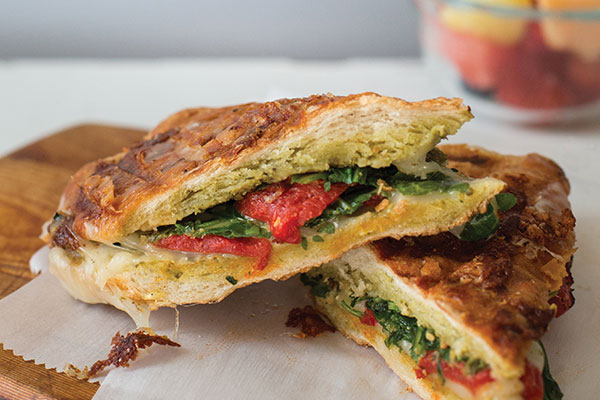Cooking Up Cancer Care
A Caregiver’s Guide to Meeting the Nutritional Needs of a Loved One with Cancer
by Jeanne Besser, Barbara L. Grant, MS, RDN, CSO, and the American Cancer Society
If you are the caregiver, it can be frustrating and difficult at times to meet the nutritional needs of a person who may not feel like eating or whose likes and dislikes can change daily. Foods may not taste normal to someone going through cancer treatment, so don’t be offended if old favorites aren’t appealing. If the person’s tastes seem to have changed, encourage new foods.
Don’t worry if there are days when the person’s diet is not as balanced as you would like. Sometimes the foods your loved one asks for or tolerates best may not be things you would normally consider to be part of a “healthy” diet. Of course, it is important to eat as well as possible during treatment, but there may be times when the goal is to take in as many calories as possible, or times when simply eating is a victory. Remember that it is okay for nutritional goals to be different right now, and days when the person is feeling better will make up for more challenging days.
Keep the fridge, freezer, and pantry stocked with easy-to-prepare foods and things that can be eaten as is.
Try to be patient and encouraging when your loved one does not feel like eating, and look for opportunities to make eating easier. Keep the fridge, freezer, and pantry stocked with easy-to-prepare foods and things that can be eaten as is. Many people going through cancer treatment experience lack of appetite or other problems that can make eating daunting or difficult. A large plate of food can be overwhelming. It sometimes works better for people dealing with side effects to snack or eat small meals throughout the day, instead of three large meals. Keeping snacks nearby can make it easier for your loved one to nibble when they do feel like eating. Also, keep items that he or she normally eats and tolerates well when sick.
Offer favorite foods any time of the day. It’s okay to have a sandwich or bowl of soup for breakfast or have breakfast food for dinner.
Here are some other tips that you may find helpful:
• Try to make mealtimes pleasant, as much as possible. Play music, watch a movie, or have friends over if your loved one is up to it.
• Offer the biggest meal of the day when he or she feels the hungriest – for many people, this is in the morning.
• Offer favorite foods any time of the day. It’s okay to have a sandwich or bowl of soup for breakfast or have breakfast food for dinner.
• Package leftovers in single-serving containers for future meals; large servings can seem overwhelming when someone’s appetite is poor.
• If your loved one is sensitive to smells, prepare meals in a different room from where they’ll be eaten. Suggest that he or she go to another room while food is being prepared. If possible, consider grilling outdoors or using a slow cooker on the back porch or in the garage to keep the smell of food from filling the house. Serving foods cool or at room temperature also decreases aromas.
• Drinking is often easier than eating. If your loved one does not feel like eating but is willing to drink, offer sips of smoothies, soups, nutritional supplements, hot cocoa, milk, and milkshakes. Soups can be sipped out of mugs and reheated as needed. Cups with lids will also help block smells.
• It is always important to follow food safety procedures, but it is especially important if you are preparing meals for someone undergoing cancer treatment, as not doing so may reduce the person’s ability to fight off infections.
Mozzarella, Pesto, and Roasted Red Pepper Panini
This recipe is appropriate for people experiencing constipation, unintentional weight loss, or taste changes. Paninis just taste good, and this one has robust flavor in addition to providing necessary calories for someone who is rebuilding during and after treatment. If your loved one isn’t a fan of roasted red peppers, substitute sun-dried tomatoes.
This can easily be made on the stovetop. If using a skillet, sprinkle the Parmesan on the pesto before layering the cheese. Cook until the bottom is golden brown, pressing the top firmly with a spatula to condense the sandwich. Carefully turn the sandwich and cook until the bottom is golden brown.
MAKES 2 TO 3 SERVINGS
2 tablespoons pesto
2 (4- to 6-inch) crusty rolls or a baguette, cut in half lengthwise
4 ounces mozzarella cheese, sliced or grated
1 roasted red bell pepper, cut into strips
1 cup arugula
1 tablespoon freshly grated Parmesan cheese
• Preheat the panini press.
• Spread the pesto on the top and bottom of the cut side of the rolls. On the bottom slices, divide the mozzarella and top with the roasted red pepper and arugula. Cover with the top of the roll.
• Place in the panini press, close to flatten, and cook for 1 to 2 minutes. Once the rolls are flattened, lift the press and sprinkle the Parmesan on the top of the rolls. Press down and cook for 3 to 5 minutes, or until both sides are golden brown and the cheese has melted.
Per Serving: Calories: 400; Fat: 15 g (7 g saturated fat); Cholesterol: 40 mg; Sodium: 940 mg; Carbohydrate: 43 g; Dietary fiber: 3 g; Sugars: 4 g; Protein: 24 g; Calcium: 520 mg; Potassium: 220 mg
©2019 American Cancer Society
Most importantly, remember that you cannot do it all yourself. Caregiving can be demanding, and it is not realistic or healthy to try to tackle everything on your own. When friends or family offer to help, accept, even if it is difficult. Look for situations where you need assistance, and jot ideas down in a notepad or on your phone. There are many ways people can help: meals, grocery shopping, helping with yardwork or housecleaning, babysitting, or even just staying with your loved one so that you can take a break. Ask others what they can do to give you a hand, and be clear about what you need. People want to help but often struggle with knowing how best to provide the assistance you need.
Remember how important it is that you also take care of yourself during this time! Eating well, being as active as possible, getting enough sleep, and practicing stress-reduction techniques can help you stay at your best so that you can offer the best care.

Jeanne Besser (left) is a former food columnist for the Atlanta Journal-Constitution and author of numerous cookbooks, including The American Cancer Society New Healthy Eating Cookbook and The Great American Eat-Right Cookbook.

A Certified Specialist in Oncology Nutrition, Barbara L. Grant (right) is an oncology dietitian nutritionist at Saint Alphonsus Cancer Care Center, where she provides nutritional counseling and survivorship classes for people with cancer.
The American Cancer Society is a nationwide, community-based voluntary health organization dedicated to eliminating cancer as a major health problem.
Adapted with permission from What to Eat During Cancer Treatment, Second Edition. Copyright ©2019 American Cancer Society, cancer.org/bookstore.
This article was published in Coping® with Cancer magazine, November/December 2018.


